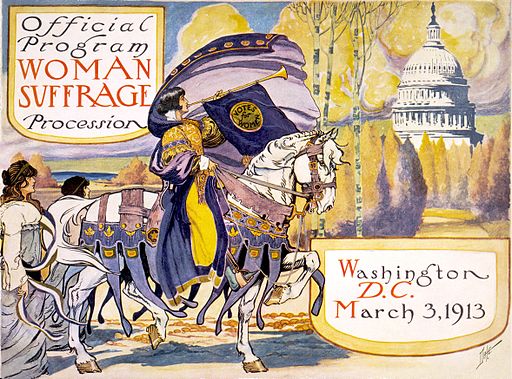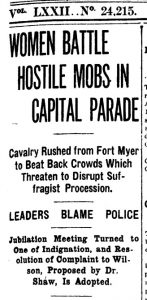In this week’s blog I’m using some of the Library’s online resources to find primary source material about a specific event, the Woman Suffrage Procession of 1913.
On 3rd March 1913 a woman suffrage procession was held in Washington DC. Not by chance was this date chosen, 3rd March was the day before a new US President, Woodrow Wilson, was inaugurated. It’s estimated that around 5000 women took part in the suffrage pageant organised by the National American Woman Suffrage Association (NAWSA) and the first of its kind in Washington DC.

Benjamin Moran Dale (1889–1951), for the National American Women’s Suffrage Association; restored by Adam Cuerden, Public domain, via Wikimedia Commons
But what started as a peaceful parade ended with the women being harassed and jeered by onlookers with the police doing little to intervene.
I have to admit I had never heard the story of this parade until I read a short article on it in the March 2017 issue of the BBC History Magazine1. And reading about it, it wasn’t hard to draw parallels with the recent Women’s March that took place in Washington DC and around the world days after the inauguration of a new US President this year.
I wanted to try and find out more about this Suffrage Parade (also referred to as Suffrage Pageant) using some of the resources available at the Library. And I wanted to focus on primary sources about the event, particularly newspaper articles.
So where better to start than by searching and browsing some of the newspaper archives for US titles that we have access to at the Library, specifically the Historical Washington Post (1877-1999), New York Tribune archive (1841-1922) and the Historical New York Times (1851-2012).
The pageant itself and the immediate aftermath
I decided to limit my search from mid-February until the end of March 1913 to catch some of the articles leading up to the event and articles that reported on the immediate consequences. And I searched each newspaper title archive individually.
In the Washington Post on 4th March 1913 the joint lead article on the front page reports on the pageant and the immediate aftermath2.

Screenshot from Proquest Historical Newspapers: The Washington Post
The headline and sub-heading of the main article are kind of hilarious and a fantastic example of gender stereotyping in newspaper reporting. However, the whole article is very positive about the pageant and gives a detailed account of the whole event, saving their ire for the troublemaking onlookers and seemingly powerless police.
As a secondary article on the front page reports “Although ambulance surgeons were assaulted, women marching in the parade were insulted and in many cases dragged out of the line and spectators, pushing and fighting with the police and each other, time after time blocked the procession so that it had to be halted while United States troops cleared a narrow lane, no arrests were made.”3

Screenshot from ProQuest Historical Newspapers: The New York Tribune
On the front page of the New York Tribune on that same day the pageant is also reported on though this time with a much different headline.
And the main focus of the article, to begin with at least, is what happened after the Pageant ended “In Continental Hall to-night the women turned what was to have been a suffrage demonstration into an indignation meeting, in which the Washington police were roundly denounced for their inactivity, and resolutions were passed calling upon President-elect Wilson and the incoming Congress to make an investigation and locate the responsibility for the indignities the marchers suffered.”4
You can read the full statement released by the NAWSA on page 10 of the same issue where not only are police accused of inactivity but also of joining in with the mob.5
By the 6th March the New York Times are reporting that the Senate have begun “an investigation to place the responsibility for the lack of protection provided for the women’s pageant on Monday”6 and that witnesses are to start being called to hearings. And on 7th March witness statements are already being heard giving a “scathing indictment against the police force of Washington.”7
The blame game
The newspapers feature almost daily articles from the Senate hearings reporting on the various and differing witness statements, with accusations and counter-accusations flying back and forth.
The Superintendent of Police Richard Sylvester was called up early on in proceedings immediately shifting “the blame and responsibility to the officers and policemen on duty on Monday who failed to protect the procession.”8 While his refusal to accept blame was widely condemned9, it was also felt by some that he was being used as a scapegoat10 and blame should be apportioned to the Congressmen and Senators11.
And it should be noted that some of the newspapers own readers felt that the suffragists themselves were to blame, as a letter to the New York Times on the 9th March12 and a separate letter on the 12th March13 show.

Screenshot from ProQuest Historical Newspapers: The New York Times with Index
Wikipedia claims that Superintendent Sylvester (though he is not named) was replaced due to these events14 but from my quick searches of these 3 newspapers I can see no evidence of this (though there may be some out there that I did not find with the quick searches that I did!) In fact Superintendent Sylvester didn’t retire until two years later, officially leaving his post in 1915. Although what happened at the Suffrage Pageant on 3rd March 1913 didn’t do his reputation any good15, there appear to have been other events that lead him to retire due to ill-health16.
Linda Lumsden looked at the press coverage of the Suffrage Pageant across 10 newspapers, including the 3 above, and contends that “parade stories and commentary became a forum on twentieth-century woman’s place. Most significantly, the riot forced even anti-suffrage newspapers to acknowledge women were citizens who possessed the right to assemble peacefully. That acknowledgement moved the media a big step closer to the inexorable conclusion women also possessed the right to vote.”17
When reading the articles regarding the Suffrage Pageant itself and the Senate hearings it does appear that the newspapers heavily sided with the suffragists and it is highly likely that the extreme reaction of the spectators that day did help their cause. In a short article written just a couple of days after the Pageant the New York Times states “The suffragist women do well to exploit their grievance, since it is a real one…they will see that “the cause” can hardly fail to profit from what happened to themselves.”18
I spent a fairly short amount of time searching these newspaper archives and it was purely to find out more about the events on 3rd March and the aftermath. I have only touched on some of the newspaper articles written about the event and did not look at many of the different issues and narratives related to this event and the various parades, pageants, marches and demonstrations that came before and after this until the right to vote was won for women in the United States. However, it shows that in just a short amount of time it is possible to find this kind of primary source material available at the University Library.
If you’re interested in seeing some photographs from the parade then I’d recommend taking a look at the Bain Collection from Library of Congress. This is a freely available site and has a number of pictures from the parade on 3 March 1913. You can also find photographs on ArtSTOR, a images database the Library subscribes to.
All the newspaper archives mentioned above can be accessed via the Newspapers, magazines or other news sources or via the Newspapers databases list.
Access is only available to current students and staff at University of Edinburgh.
Caroline Stirling – Academic Support Librarian for History, Classics and Archaeology
Notes
- Dominic Sandbrook, “Women’s suffrage takes off in Washington DC,” BBC History Magazine, March 2017, 6.
- “Women’s Beauty, Grace, And Art Bewilder The Capital: Miles of Fluttering Femininity Present Entrancing Suffrage Appeal,” The Washington Post, March 4, 1913. https://search-proquest-com.ezproxy.is.ed.ac.uk/docview/145222197?accountid=10673.
- “100 Are In Hospital: Crowds Trample Men; Women Faint In Crush,” The Washington Post, March 4, 1913. https://search-proquest-com.ezproxy.is.ed.ac.uk/docview/145225129?accountid=10673.
- A Staff Correspondent of,The Tribune. “Women Battle Hostile Mobs In Capital Parade: Cavalry Rushed from Fort Myer to Beat Back Crowds Which Threaten to Disrupt Suffragist Procession,” New York Tribune, March 4, 1913. https://search-proquest-com.ezproxy.is.ed.ac.uk/docview/575057668?accountid=10673.
- “Women Issue A Protest: Members of Congress Promise Inquiry Into Parade Rioting,” New York Tribune, March 4, 1913. https://search-proquest-com.ezproxy.is.ed.ac.uk/docview/575043019?accountid=10673.
- “Senate Police Inquiry On: Committee Ready to Investigate the Charges Made by Suffrage Marchers,” New York Times, March 6, 1913. https://search-proquest-com.ezproxy.is.ed.ac.uk/docview/97372512?accountid=10673.
- “Police Idly Watched Abuse of Women: Shocking Insults to Suffrage Paraders Testified To at Washington Inquiry,” New York Times, March 7, 1913. https://search-proquest-com.ezproxy.is.ed.ac.uk/docview/97367294?accountid=10673.
- “Sylvester Shocked At Insults To Women: Washington Police Chief Puts Blame for Suffrage Parade Disorder on Officers and Men,” New York Times, March 9, 1913. https://search-proquest-com.ezproxy.is.ed.ac.uk/docview/97517979?accountid=10673.
- “Men In Police Attack: Take Up Suffragists’ Plaint Of “No Protection”,” The Washington Post, March 10, 1913. https://search-proquest-com.ezproxy.is.ed.ac.uk/docview/145224670?accountid=10673.
- “Play To Grand Stand: Dr. Walters Says Senators Are Making Sylvester A ‘Goat’,” The Washington Post, March 11, 1913. https://search-proquest-com.ezproxy.is.ed.ac.uk/docview/145223905?accountid=10673.
- Ida Husted Harper, “Capital Mobs Made Converts To Suffrage: Public Should Look For “the Men Higher Up,” Says Leader in Votes-for-Women Crusade,” New York Tribune, March 8, 1913. https://search-proquest-com.ezproxy.is.ed.ac.uk/docview/575068704?accountid=10673.
- Everett P. Wheeler, “Suffragists Odious: So Mr. Wheeler Explains Their Ill-Treatment in Washington,” New York Times, March 9, 1913. https://search-proquest-com.ezproxy.is.ed.ac.uk/docview/97442696?accountid=10673.
- Annie Nathan Meyer, “Woman Suffrage Paraders: Themselves Declared to Blame for Ill-Treatment at Washington,” New York Times, March 12, 1913. https://search-proquest-com.ezproxy.is.ed.ac.uk/docview/97480955?accountid=10673.
- “Woman suffrage parade of 1913.” Wikipedia, last modified March 3, 2017, accessed March 3, 2017, https://en.wikipedia.org/wiki/Woman_suffrage_parade_of_1913.
- “Chief Sylvester Out: Head of Washington Police Retires After Charges Are Withdrawn,” New York Times, March 6, 1915. https://search-proquest-com.ezproxy.is.ed.ac.uk/docview/97716893?accountid=10673.
- “Sylvester To Retire: Asks D.C. Board to Pension Him Because of Ill Health,” The Washington Post, March 5, 1915. https://search-proquest-com.ezproxy.is.ed.ac.uk/docview/145401303?accountid=10673.
- Linda J. Lumsden, “Beauty and the Beasts: Significance of Press Coverage of the 1913 National Suffrage Parade,” Journalism & Mass Communication Quarterly 77, no. 3 (September 2000): 593.
- “Topics Of The Times,” New York Times, March 5, 1913. https://search-proquest-com.ezproxy.is.ed.ac.uk/docview/97468122?accountid=10673.

Pingback: #100years: “Because…we want to get on with our work more quickly” | HCA Librarian